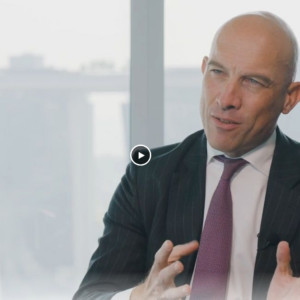Brighter times for bonds boost innovation in fixed income ETF space

Investors are looking to bonds for diversification and yields, and ETF providers have responded with new products to meet growing demand.
The aggressive interest rate hikes implemented by central banks since early 2022 to combat persistent inflation have created interesting opportunities for fixed income investors, while also spurring product innovation, not least in the exchange traded fund (ETF) space.
Bond ETFs have traditionally lagged their equity counterparts but are rapidly catching up in this more favourable environment, after decades of ultra-low interest rates.
“We are approaching the end of this relentless hiking cycle which means now is the time for investors to lock-in those yields and generate income in portfolios and also rely on bonds for diversification, which hasn't been the case in previous years,” says Vasiliki Pachatouridi, head of Emea iShares fixed income strategy.
Flows into the Ucits bond ETF industry have hit €40bn ($43bn) year to date, with the majority (€27.6bn) going into government bonds, with US Treasury ETFs in particular attracting €12.9bn, according to BlackRock Bloomberg. Investors clearly sought to benefit from increasing bond yields and redress imbalances in portfolios, which have been underweight in fixed income for many years.
Around 80 per cent of the fixed income market now is yielding four per cent or greater, according to BlackRock. Twenty-two per cent of these fixed income segments are accounted for by US Treasuries, a percentage last seen in 1999.
“From 2010 to 2022, every time a client asked me to construct a fixed income portfolio yielding four per cent, I could only play with emerging market debt and high yield. Now that has changed dramatically. We are in a new regime,” says Ms Pachatouridi, who joined her current employer in 2007.
In this improved environment, provider iShares by BlackRock has recently launched five iBonds ETFs, extending its range of fixed income maturity Ucits ETFs to nine funds, now with maturities ranging from 2025 to 2028.
In particular, the iShares iBonds Dec 2025, which gives exposure to short-dated Treasuries, is an “interesting addition” to the iBond Ucits range, says Ms Pachatouridi. “This is the part of the US Treasury favoured by many of our clients, offering the best risk returns from the yield perspective.”
iBonds are ETFs that behave similarly to bonds and mature on a defined date. Unlike traditional bond ETFs, which never mature – as the bonds they hold at the maturity date are constantly reinvested into the next issuance – iBonds invest in a diversified set of bonds all maturing in the year specified in the name of the iBond. This means investors get their money back at maturity, just like a bond. The income streams they produce are not fixed but depend on the coupons paid by the underlying bonds.
“iBonds are ETFs designed to mature like a bond, trade like a stock, diversify like a fund and all of that in the cost effective and transparent ETF structure,” says Ms Pachatouridi
With $23bn in assets across more than 30 iBonds in the US, with the first launched in 2010, iShares is the first firm to launch fixed maturity ETFs in Emea. Its initial four iBonds, launched in August, have already attracted more than $135m in client assets.
Diversified portfolios
“iBonds are an elegant solution for advisers, who use them as an alternative to single bonds or as a complement to custom single bond portfolios,” says Ms Pachatouridi.
A key challenge for advisers is to scale their businesses and create efficiencies across accounts and clients, and single bond portfolios are not scalable, she adds.
ETFs provide access and diversification and can replace many holdings, minimising the need to source and manage individual bonds.
Moreover, advisers can use iBonds to create scalable diversified portfolio ladders, using just a few ETFs, rather than trading numerous bonds. By buying bonds with differing maturity dates, investors can stagger final payouts, and reinvest into funds with subsequent consecutive maturities, creating bond ladders and capture defined yields over set investment periods.
Asset allocation
Bonds are at last back on the agenda of chief investment officers and market strategists at private banks, who rely on the asset class as a source of diversification and income in client portfolios.
More than 50 per cent of private banks who took part in PWM’s eighth annual Global Asset allocation Tracker (GAT) study earlier this year had an overweight tactical allocation to bonds. The 51 institutions taking part in the study managed a combined $18tn in client assets.
Around 40 per cent of them expected bond ETFs to increase in client portfolios as a proportion of total assets over the course of this year, versus 37 per cent for equity ETFs.
“Bond yields are significantly higher than the latest 10-year averages and we reached a better yield equilibrium,” observes Zeynep Ozturk-Unlu, Deutsche Bank Private Bank CIO Emea, explaining the bank has now an overweight position to fixed income.
There is a clear preference is for ‘quality’ bonds.
“With market participants concerned about a sharp economic slowdown, which we however consider unlikely to materialise, US dollar investment grade (IG) and euro IG credit should gain favour among investors, rendering their high quality and decent yields attractive and tightening their spreads,” says Ms Ozturk-Unlu, who will be speaking at the upcoming FT Wealth Management Summit on how to rebalance portfolios to withstand market stress.
With any possible slowdown likely to be over by the end of the forecast horizon, any widening in the near term is likely to act as a buying opportunity, she adds.
The main risk about bonds is uncertainty around central banks’ actions. The market is pricing in a pause, no hike and then cuts from the US Fed. And it is also pricing in one more hike, pause and then cuts from the European Central Bank. If these events happen, there is low risk.
Further hawkish rate hikes can be a downside risk for credit, explains Ms Ozturk-Unly, adding that liquidity and availability are not a major concern with IG names, also considering healthy reissues.
Deutsche Bank constructs discretionary portfolios with a “wide range” of fixed income liquid instruments, including ETFs, which are also adopted in the bank’s ETF-only strategies.
Alternative to equity
“Market conditions have changed dramatically since 2022, particularly for bonds,” observes Edmond de Rothschild’s global CIO Lars Kalbreier. Government bond yields have risen significantly, by 400 to 500 basis points depending on the country, offering an alternative to equities in terms of return.
“In a context of decelerating inflation and higher risk of global slowdown, we have a preference for bonds over equities, as they are one of few assets to offer attractive return and protection in case of marked slowdown,” says Mr Kalbreier.
Quality bonds such as US treasuries and IG bonds offer a “very attractive” risk/return profile, whereas current spreads on high yield are seen as too tight and not sufficient to compensate for the widening that would occur in case of a slowdown larger than currently priced by investors.
“With the Fed nearing its monetary tightening peak, expected return for US sovereign bonds and IG credit can be important in the period following the last Fed hike,” he says. Moreover, in each of the hike cycles since 1990, the pattern of performance observed after the end of Fed tightening is much more stable for quality bonds than for equities or high yield bonds, adds Mr Kalbreier.
Technical challenges
Edmond de Rothschild’s preference is for direct lines and select names and sectors, if suitable to client’s profile. “Being selective within fixed income is key because dispersion across sectors or countries can be significant,” he says.
“Higher uncertainty on the end of the hike cycle of major central banks is source of volatility and creates opportunities for actively managed funds to generate alpha in specific sectors, such as financial bonds.”
As a result, at the bank bond ETFs are only used in client portfolios to gain exposure to developed sovereign bond markets.
Liquidity for bond ETFs is lower than for equity ETFs and this could translate into valuation premiums or discounts for bond ETFs versus their underlying bond holdings, which ultimately contributes to volatility, says Mr Kalbreier, referencing the latest study from the Fed.
“Overall, we believe that bond ETFs are liquid instruments and can be used efficiently in a client’s portfolio but still face some technical challenges.”
While cost efficiency is a “clear advantage” of bond ETFs for clients, he would welcome a “larger segmentation” of ETFs tracking well-known benchmarks, such as the Bloomberg Global Agg, and specific sectors or thematics.
“Segments we are most interested in would be developed markets low investment grade (BBB) with short to moderate durations, or subordinated bonds issued by solid credits.”
From a sector point of view, he would like to see bond ETFs focused on car manufacturers and automotive suppliers, telecoms, or banks.





